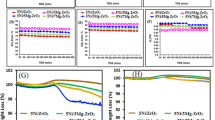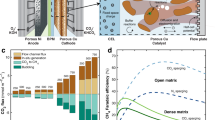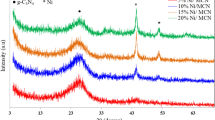Abstract
Developing a direct carbon dioxide (CO2) capture and methanation method is one of the most important challenges to achieving carbon neutrality. However, converting CO2 into methane (CH4) kinetically requires the activation of stable CO2 at high temperatures (300–500 °C), while the CO2-to-CH4 conversion thermodynamically favours low temperatures. Here we report an efficient mechanochemical CO2 capture and conversion under mild conditions (65 °C). Using commercial zirconium oxide (ZrO2) and nickel catalysts, the mechanochemical CO2 capture capacity was 75-fold higher than the conventional thermochemical process. The mechanochemical CO2 conversion reached a nearly quantitative CO2 conversion (99.2%) with CH4 selectivity (98.8%). We determined that repeatedly induced abundant oxygen vacancies on ZrO2 by dynamic mechanical actions are responsible for efficient CO2 capture and, thus, subsequently spontaneous methanation.
This is a preview of subscription content, access via your institution
Access options




Similar content being viewed by others
Data availability
All data that support the findings of this study are presented in the article and its Supplementary Information and are available from the corresponding author upon reasonable request.
References
Davis, S. J. et al. Net-zero emissions energy systems. Science 360, eaas9793 (2018).
Shakun, J. D. et al. Global warming preceded by increasing carbon dioxide concentrations during the last deglaciation. Nature 484, 49–54 (2012).
Seneviratne, S. I., Donat, M. G., Pitman, A. J., Knutti, R. & Wilby, R. L. Allowable CO2 emissions based on regional and impact-related climate targets. Nature 529, 477–483 (2016).
Chu, S. & Majumdar, A. Opportunities and challenges for a sustainable energy future. Nature 488, 294–303 (2012).
Mac Dowell, N., Fennell, P. S., Shah, N. & Maitland, G. C. The role of CO2 capture and utilization in mitigating climate change. Nat. Clim. Chang. 7, 243–249 (2017).
Kang, Z., Liao, Q., Zhang, Z. & Zhang, Y. Carbon neutrality orientates the reform of the steel industry. Nat. Mater. 21, 1094–1098 (2022).
Tan, T. H. et al. Unlocking the potential of the formate pathway in the photo-assisted Sabatier reaction. Nat. Catal. 3, 1034–1043 (2020).
Fan, M. et al. Single-site decorated copper enables energy- and carbon-efficient CO2 methanation in acidic conditions. Nat. Commun. 14, 3314 (2023).
Tébar-Soler, C. et al. Low-oxidation-state Ru sites stabilized in carbon-doped RuO2 with low-temperature CO2 activation to yield methane. Nat. Mater. 22, 762–768 (2023).
Kang, H. et al. Understanding the complexity in bridging thermal and electrocatalytic methanation of CO2. Chem. Soc. Rev. 52, 3627–3662 (2023).
Jiang, H. et al. Light-driven CO2 methanation over Au-grafted Ce0.95Ru0.05O2 solid-solution catalysts with activities approaching the thermodynamic limit. Nat. Catal. 6, 519–530 (2023).
Zhang, X. et al. Reversible loss of core–shell structure for Ni–Au bimetallic nanoparticles during CO2 hydrogenation. Nat. Catal. 3, 411–417 (2020).
Song, Y. et al. Dry reforming of methane by stable Ni–Mo nanocatalysts on single-crystalline MgO. Science 367, 777–781 (2020).
Beaumont, S. K. et al. Combining in situ NEXAFS spectroscopy and CO2 methanation kinetics to study Pt and Co nanoparticle catalysts reveals key insights into the role of platinum in promoted cobalt catalysis. J. Am. Chem. Soc. 136, 9898–9901 (2014).
Vogt, C., Monai, M., Kramer, G. J. & Weckhuysen, B. M. The renaissance of the Sabatier reaction and its applications on earth and in space. Nat. Catal. 2, 188–197 (2019).
Zhu, X. et al. Supercharged CO2 photothermal catalytic methanation: high conversion, rate, and selectivity. Angew. Chem. Int. Ed. 62, e202218694 (2023).
Ahmad, F. et al. Low-temperature CO2 methanation: synergistic effects in plasma-Ni hybrid catalytic system. ACS Sustain. Chem. Eng. 8, 1888–1898 (2020).
Li, Y. et al. Promoting CO2 methanation via ligand-stabilized metal oxide clusters as hydrogen-donating motifs. Nat. Commun. 11, 6190 (2020).
Han, G.-F. et al. Mechanochemistry for ammonia synthesis under mild conditions. Nat. Nanotechnol. 16, 325–330 (2021).
Reichle, S., Felderhoff, M. & Schuth, F. Mechanocatalytic room-temperature synthesis of ammonia from its elements down to atmospheric pressure. Angew. Chem. Int. Ed. 60, 26385–26389 (2021).
Han, G.-F. et al. Extreme enhancement of carbon hydrogasification via mechanochemistry. Angew. Chem. Int. Ed. 61, e202117851 (2022).
Eckert, R., Felderhoff, M. & Schüth, F. Preferential carbon monoxide oxidation over copper-based catalysts under in-situ ball milling. Angew. Chem. Int. Ed. 56, 2445–2448 (2017).
Amrute, A. P., Łodziana, Z., Schreyer, H., Weidenthaler, C. & Schüth, F. High-surface-area corundum by mechanochemically induced phase transformation of boehmite. Science 366, 485–489 (2019).
Zholdassov, Y. S. et al. Acceleration of Diels–Alder reactions by mechanical distortion. Science 380, 1053–1058 (2023).
Zhang, W. et al. Deforming lanthanum trihydride for superionic conduction. Nature 616, 73–76 (2023).
Khajavi, S., Rajabi, M. & Huot, J. Effect of cold rolling and ball milling on first hydrogenation of Ti0.5Zr0.5 (Mn1-xFex) Cr1, x=0, 0.2, 0.4. J. Alloy. Compd. 775, 912–920 (2019).
Han, G.-F. et al. Abrading bulk metal into single atoms. Nat. Nanotechnol. 17, 403–407 (2022).
Sullivan, I. et al. Coupling electrochemical CO2 conversion with CO2 capture. Nat. Catal. 4, 952–958 (2021).
Duyar, M. S., Treviño, M. A. A. & Farrauto, R. J. Dual function materials for CO2 capture and conversion using renewable H2. Appl. Catal. B 168–169, 370–376 (2015).
Espinal, L., Poster, D. L., Wong-Ng, W., Allen, A. J. & Green, M. L. Measurement, standards, and data needs for CO2 capture materials: a critical review. Environ. Sci. Technol. 47, 11960–11975 (2013).
Wang, Q., Luo, J., Zhong, Z. & Borgna, A. CO2 capture by solid adsorbents and their applications: current status and new trends. Energy Environ. Sci. 4, 42–55 (2011).
Mazheika, A. et al. Artificial-intelligence-driven discovery of catalyst genes with application to CO2 activation on semiconductor oxides. Nat. Commun. 13, 419 (2022).
Ndayiragije, S. et al. Mechanochemically tailoring oxygen vacancies of MnO2 for efficient degradation of tetrabromobisphenol A with peroxymonosulfate. Appl. Catal. B 307, 121168 (2022).
Jia, X., Zhang, X., Rui, N., Hu, X. & Liu, C.-j Structural effect of Ni/ZrO2 catalyst on CO2 methanation with enhanced activity. Appl. Catal. B 244, 159–169 (2019).
Wei, X. et al. Oxygen vacancy-mediated selective C–N coupling toward electrocatalytic urea synthesis. J. Am. Chem. Soc. 144, 11530–11535 (2022).
Liu, J. et al. Enhanced visible-light photocatalytic activity of carbonate-doped anatase TiO2 based on the electron-withdrawing bidentate carboxylate linkage. Appl. Catal. B 202, 642–652 (2017).
Belgamwar, R. et al. Defects tune the strong metal–support interactions in copper supported on defected titanium dioxide catalysts for CO2 reduction. J. Am. Chem. Soc. 145, 8634–8646 (2023).
Han, G.-F. et al. Dissociating stable nitrogen molecules under mild conditions by cyclic strain engineering. Sci. Adv. 5, eaax8275 (2019).
Ren, J., Zeng, F., Mebrahtu, C. & Palkovits, R. Understanding promotional effects of trace oxygen in CO2 methanation over Ni/ZrO2 catalysts. J. Catal. 405, 385–390 (2022).
Zhu, M. et al. Vacancy engineering of the nickel-based catalysts for enhanced CO2 methanation. Appl. Catal. B 282, 119561 (2021).
Westermann, A. et al. Insight into CO2 methanation mechanism over NiUSY zeolites: an operando IR study. Appl. Catal. B 174–175, 120–125 (2015).
Pan, Q., Peng, J., Sun, T., Wang, S. & Wang, S. Insight into the reaction route of CO2 methanation: promotion effect of medium basic sites. Catal. Commun. 45, 74–78 (2014).
Baláž, P. Mechanochemistry in Nanoscience and Minerals Engineering (Springer, 2008).
Lee, T. H. & Elliott, S. R. Ab initio computer simulation of the early stages of crystallization: application to Ge2Sb2Te5 phase-change materials. Phys. Rev. Lett. 107, 145702 (2011).
Sun, J., Ruzsinszky, A. & Perdew, J. P. Strongly constrained and appropriately normed semilocal density functional. Phys. Rev. Lett. 115, 036402 (2015).
Blöchl, P. E. Projector augmented-wave method. Phys. Rev. B 50, 17953–17980 (1994).
Dudarev, S. L., Botton, G. A., Savrasov, S. Y., Humphreys, C. J. & Sutton, A. P. Electron-energy-loss spectra and the structural stability of nickel oxide: an LSDA + U study. Phys. Rev. B 57, 1505–1509 (1998).
Grimme, S., Ehrlich, S. & Goerigk, L. Effect of the damping function in dispersion corrected density functional theory. J. Comput. Chem. 32, 1456–1465 (2011).
Moellmann, J. & Grimme, S. DFT-D3 study of some molecular crystals. J. Phys. Chem. C 118, 7615–7621 (2014).
Henkelman, G., Uberuaga, B. P. & Jónsson, H. A climbing image nudged elastic band method for finding saddle points and minimum energy paths. J. Chem. Phys. 113, 9901–9904 (2000).
Acknowledgements
This work was supported by research programmes (RS-2023-00221668, RS-2024-00435493 and RS-2024-00466616 to J.-B.B.) through the National Research Foundation (NRF) of Korea, Carbon Neutrality Demonstration and Research Center (1.240027.01 to H.L.), National Natural Science Foundation of China (21873088 to Q.X.L.) and the Innovation Program for Quantum Science and Technology (no. 2021ZD0303306 to Q.X.L.). The computational resources are provided by the Supercomputing Center of University of Science and Technology of China.
Author information
Authors and Affiliations
Contributions
J.-B.B. conceived the project and oversaw all the research phases. R.G. conducted experiments and characterizations. L.S. carried out DFT calculations. J.G. performed the economic analysis. C.L., J.-M.S., B.-J.J., S.-H.K. and J.K. helped with characterizations. J.-M.S. helped with visualization. R.G., L.S., J.G., H.L., Q.X.L. and J.-B.B. co-wrote the paper, and all the authors commented on it.
Corresponding authors
Ethics declarations
Competing interests
The authors declare no competing interests.
Peer review
Peer review information
Nature Nanotechnology thanks Ding Ma and the other, anonymous, reviewer(s) for their contribution to the peer review of this work.
Additional information
Publisher’s note Springer Nature remains neutral with regard to jurisdictional claims in published maps and institutional affiliations.
Supplementary information
Supplementary Information
Supplementary methods, texts, Figs. 1–43, Tables 1–5 and references.
Supplementary Video 1
Presentation of mechanochemical CO2 methanation.
Rights and permissions
Springer Nature or its licensor (e.g. a society or other partner) holds exclusive rights to this article under a publishing agreement with the author(s) or other rightsholder(s); author self-archiving of the accepted manuscript version of this article is solely governed by the terms of such publishing agreement and applicable law.
About this article
Cite this article
Guan, R., Sheng, L., Li, C. et al. Mechanochemical carbon dioxide capture and conversion. Nat. Nanotechnol. (2025). https://doi.org/10.1038/s41565-025-01949-6
Received:
Accepted:
Published:
DOI: https://doi.org/10.1038/s41565-025-01949-6



